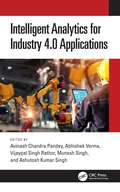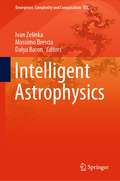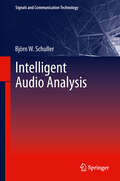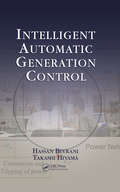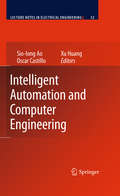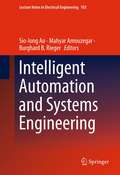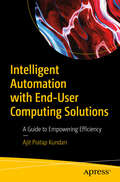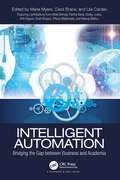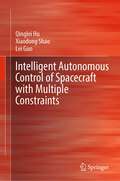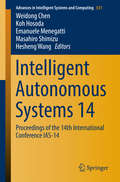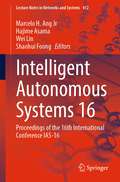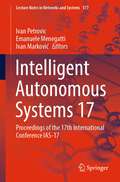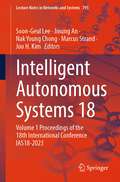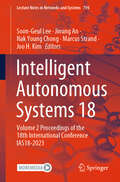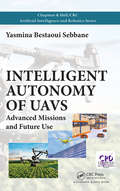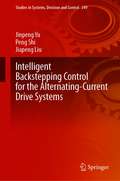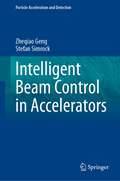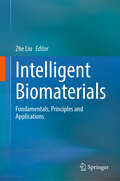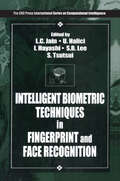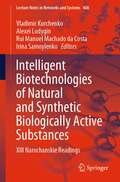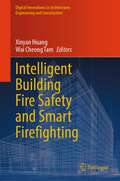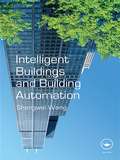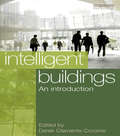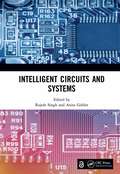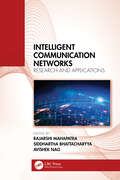- Table View
- List View
Intelligent Analytics for Industry 4.0 Applications
by Abhishek Verma Ashutosh Kumar Singh Avinash Chandra Pandey Vijaypal Singh Rathor Munesh SinghThe advancements in intelligent decision-making techniques have elevated the efficiency of manufacturing industries and led to the start of the Industry 4.0 era. Industry 4.0 is revolutionizing the way companies manufacture, improve, and distribute their products. Manufacturers are integrating new technologies, including the Internet of Things (IoT), cloud computing and analytics, and artificial intelligence and machine learning, into their production facilities throughout their operations. In the past few years, intelligent analytics has emerged as a solution that examines both historical and real-time data to uncover performance insights. Because the amount of data that needs analysis is growing daily, advanced technologies are necessary to collect, arrange, and analyze incoming data. This approach enables businesses to detect valuable connections and trends and make decisions that boost overall performance. In Industry 4.0, intelligent analytics has a broader scope in terms of descriptive, predictive, and prescriptive subdomains. To this end, the book will aim to review and highlight the challenges faced by intelligent analytics in Industry 4.0 and present the recent developments done to address those challenges.
Intelligent Astrophysics (Emergence, Complexity and Computation #39)
by Ivan Zelinka Massimo Brescia Dalya BaronThis present book discusses the application of the methods to astrophysical data from different perspectives. In this book, the reader will encounter interesting chapters that discuss data processing and pulsars, the complexity and information content of our universe, the use of tessellation in astronomy, characterization and classification of astronomical phenomena, identification of extragalactic objects, classification of pulsars and many other interesting chapters. The authors of these chapters are experts in their field and have been carefully selected to create this book so that the authors present to the community a representative publication that shows a unique fusion of artificial intelligence and astrophysics.
Intelligent Audio Analysis
by Björn W. SchullerThis book provides the reader with the knowledge necessary for comprehension of the field of Intelligent Audio Analysis. It firstly introduces standard methods and discusses the typical Intelligent Audio Analysis chain going from audio data to audio features to audio recognition. Further, an introduction to audio source separation, and enhancement and robustness are given. After the introductory parts, the book shows several applications for the three types of audio: speech, music, and general sound. Each task is shortly introduced, followed by a description of the specific data and methods applied, experiments and results, and a conclusion for this specific task. The books provides benchmark results and standardized test-beds for a broader range of audio analysis tasks. The main focus thereby lies on the parallel advancement of realism in audio analysis, as too often today's results are overly optimistic owing to idealized testing conditions, and it serves to stimulate synergies arising from transfer of methods and leads to a holistic audio analysis.
Intelligent Automatic Generation Control
by Hassan Bevrani Takashi HiyamaAutomatic generation control (AGC) is one of the most important control problems in the design and operation of interconnected power systems. Its significance continues to grow as a result of several factors: the changing structure and increasing size, complexity, and functionality of power systems, the rapid emergence (and uncertainty) of renewable energy sources, developments in power generation/consumption technologies, and environmental constraints. Delving into the fundamentals of power system AGC, Intelligent Automatic Generation Control explores ways to make the infrastructures of tomorrow smarter and more flexible. These frameworks must be able to handle complex multi-objective regulation optimization problems, and they must be highly diversified in terms of policies, control strategies, and wide distribution in demand and supply sources—all via an intelligent scheme. The core of such intelligent systems should be based on efficient, adaptable algorithms, advanced information technology, and fast communication devices to ensure that the AGC systems can maintain generation-load balance following serious disturbances. This book addresses several new schemes using intelligent control techniques for simultaneous minimization of system frequency deviation and tie-line power changes, which is required for successful operation of interconnected power systems. It also concentrates on physical and engineering aspects and examines several developed control strategies using real-time simulations. This reference will prove useful for engineers and operators in power system planning and operation, as well as academic researchers and students in field of electrical engineering.
Intelligent Automation and Computer Engineering
by He Huang Oscar CastilloA large international conference in Intelligent Automation and Computer Engineering was held in Hong Kong, March 18-20, 2009, under the auspices of the International MultiConference of Engineers and Computer Scientists (IMECS 2009). The IMECS is organized by the International Association of Engineers (IAENG). Intelligent Automation and Computer Engineering contains 37 revised and extended research articles written by prominent researchers participating in the conference. Topics covered include artificial intelligence, decision supporting systems, automated planning, automation systems, control engineering, systems identification, modelling and simulation, communication systems, signal processing, and industrial applications. Intelligent Automation and Computer Engineering offers the state of the art of tremendous advances in intelligent automation and computer engineering and also serves as an excellent reference text for researchers and graduate students, working on intelligent automation and computer engineering.
Intelligent Automation and Systems Engineering
by Sio-Iong Ao Burghard B. Rieger Mahyar AmouzegarIntelligent systems are required to facilitate the use of information provided by the internet and other computer based technologies. This book describes the state-of-the-art in Intelligent Automation and Systems Engineering. Topics covered include Intelligent decision making, Automation, Robotics, Expert systems, Fuzzy systems, Knowledge-based systems, Knowledge extraction, Large database management, Data analysis tools, Computational biology, Optimization algorithms, Experimental designs, Complex system identification, Computational modeling, Systems simulation, Decision modeling, and industrial applications.
Intelligent Automation with End-User Computing Solutions: A Guide to Empowering Efficiency
by Ajit Pratap KundanIntelligent Automation with End Computing Solutions" is a comprehensive book that delves into the intersection of intelligent automation and end computing, exploring the synergies between these two transformative technologies. This book addresses the fundamental concepts, applications, and implications of integrating intelligent automation with end computing solutions. The main topics covered in the book revolve around the integration of intelligent automation techniques, such as artificial intelligence (AI) and machine learning (ML), with end computing infrastructure. The book addresses this need by providing insights into how intelligent automation can be seamlessly integrated with end computing to create powerful and responsive systems. The authors also explore case studies and real-world examples where the integration of intelligent automation and end computing has led to significant improvements in various domains, such as manufacturing, healthcare, and smart cities. Readers will gain valuable knowledge about optimizing automation workflows, improving decision-making processes, and achieving operational excellence through the integration of intelligent automation with end computing solutions. In conclusion, "Intelligent Automation with End Computing Solutions" is a timely and essential resource for professionals, researchers, and decision-makers aiming to navigate the evolving landscape of automation and computing. The book equips its readers with the knowledge and tools necessary to harness the combined power of intelligent automation and end computing, paving the way for innovative and efficient solutions in the digital age. You Will: Learn fundamental concepts, applications, and implications of integrating intelligent automation with end computing solutions Optimizing automation workflows, improving decision-making processes, and achieving operational excellence through the integration of intelligent automation with end computing solutions. Learn through case studies and real-world examples from industries like manufacturing, healthcare, and smart cities, showcasing tangible benefits and transformative outcomes. · <p class="MsoNormal" style="ma
Intelligent Automation: Bridging the Gap between Business and Academia
by Marie Myers Carol Brace Lila CardenSince prehistoric times, humans have invented ways to simplify daily activities to improve productivity. The most recent milestone in this journey is robotic process automation (RPA), helping to build software robots that can be leveraged to automate mundane and repetitive tasks that can be labor-intensive and prone to errors. In recent years, RPA has been integrated with emerging artificial intelligence (AI) and machine learning (ML) technologies to create what is referred to as intelligent automation (IA), emulating human actions and decision-making abilities. This book addresses the critical questions about the rise, usage, and future of IA practices. This book is structured by general personas considered as its primary target audience, ranging from: Early-stage practitioners seeking to learn effective management of IA programs Established IA practitioners seeking to drive maturity and scale Business leaders seeking to understand how to drive business value using IA Practitioners or academicians seeking to collaborate This book is strongly recommended for practitioners seeking to plan, implement, and scale IA practices in their organization and for researchers and students who intend to study strategy, implementation, and management of IA practice to accelerate the digital transformation agenda.
Intelligent Autonomous Control of Spacecraft with Multiple Constraints
by Lei Guo Qinglei Hu Xiaodong ShaoThis book explores the intelligent autonomous control problems for spacecraft with multiple constraints, such as pointing/path constraints, linear/angular velocity constraints, performance constraints, etc. It provides an almost self-contained presentation of dynamics modeling, controller design and analysis, as well as simulation studies. The book aims to offer a valuable guide for researchers and aerospace engineers to address the theoretical and technical difficulties in different applications, ranging from spacecraft attitude reorientation and tracking to spacecraft proximity operations, and is mainly intended for technical and engineering staff engaged in spacecraft dyanmics and control areas.
Intelligent Autonomous Systems 14
by Emanuele Menegatti Weidong Chen Koh Hosoda Masahiro Shimizu Hesheng WangThis book describes the latest research advances, innovations, and visions in the field of robotics as presented by leading researchers, engineers, and practitioners from around the world at the 14th International Conference on Intelligent Autonomous Systems (IAS-14), held in Shanghai, China in July 2016. The contributions amply demonstrate that robots, machines and systems are rapidly achieving intelligence and autonomy, attaining more and more capabilities such as mobility and manipulation, sensing and perception, reasoning, and decision-making. They cover a wide range of research results and applications, and particular attention is paid to the emerging role of autonomous robots and intelligent systems in industrial production, which reflects their maturity and robustness. The contributions were selected by means of a rigorous peer-review process and highlight many exciting and visionary ideas that will further galvanize the research community and spur novel research directions. The series of biennial IAS conferences, which began in 1986, represents a premiere event in the field of robotics.
Intelligent Autonomous Systems 16: Proceedings of the 16th International Conference IAS-16 (Lecture Notes in Networks and Systems #412)
by Wei Lin Marcelo H. Ang Jr Hajime Asama Shaohui FoongThis book presents the latest advances and research achievements in the fields of autonomous robots and intelligent systems, presented at the IAS-16 conference, conducted virtually in Singapore, from 22 to 25 June 2021. IAS is a common platform for an exchange and sharing of ideas among the international scientific research and technical community on some of the main trends of robotics and autonomous systems: navigation, machine learning, computer vision, control, and robot design—as well as a wide range of applications. IAS-16 reflects the rise of machine learning and deep learning developments in the robotics field, as employed in a variety of applications and systems. All contributions were selected using a rigorous peer-reviewed process to ensure their scientific quality. Despite the challenge of organising a conference during a pandemic, the IAS biennial conference remains an essential venue for the robotics and autonomous systems community ever since its inception in 1986.Chapters 46 of this book is available open access under a CC BY 4.0 license at link.springer.com
Intelligent Autonomous Systems 17: Proceedings of the 17th International Conference IAS-17 (Lecture Notes in Networks and Systems #577)
by Emanuele Menegatti Ivan Petrovic Ivan Marković“IAS has been held every two years since 1986 providing venue for the latest accomplishments and innovations in advanced intelligent autonomous systems. New technologies and application domains continuously pose new challenges to be overcome in order to apply intelligent autonomous systems in a reliable and user-independent way in areas ranging from industrial applications to professional service and household domains. The present book contains the papers presented at the 17th International Conference on Intelligent Autonomous Systems (IAS-17), which was held from June 13–16, 2022, in Zagreb, Croatia. In our view, 62 papers, authored by 196 authors from 19 countries, are a testimony to the appeal of the conference considering travel restrictions imposed by the COVID-19 pandemic. Our special thanks go to the authors and the reviewers for their effort—the results of their joint work are visible in this book. We look forward to seeing you at IAS-18 in 2023 in Suwon, South Korea!”
Intelligent Autonomous Systems 18: Volume 1 Proceedings of the 18th International Conference IAS18-2023 (Lecture Notes in Networks and Systems #795)
by Marcus Strand Soon-Geul Lee Jinung An Nak Young Chong Joo H. KimIntelligent autonomous systems are increasingly being applied in various fields, ranging from industrial applications to professional services and household domains. These advancements in technology and application domains have brought forth the need for continuous research and development to address new challenges in deploying intelligent autonomous systems in a reliable and user-independent manner. This book is a compilation that aims to serve researchers and practitioners in related fields by providing a timely dissemination of recent progress in the areas of autonomous mobility and robotics. The contents of this book are based on a collection of papers presented at the 18th International Conference on Intelligent Autonomous Systems (IAS18 2023), held at the Suwon Convention Center in Suwon, Korea. The conference took place fully in person from July 4 to 7, 2023, with the theme “Impact and Effect of AI on Intelligent Autonomous Systems.” It encompassed discussions on theories, applications, and creative innovations in intelligent autonomous systems, covering topics such as autonomous vehicles, intelligent agents, smart sensors and actuators, smart haptics, human–machine interaction, digital twin, digital health, and metaverse, VR, AR, or MR. For ease of reading, the 91 papers have been grouped into five chapters: Chapter 1: Intelligent Autonomous Vehicles; Chapter 2: Autonomous Robots; Chapter 3: Intelligent Perception and Sensors; Chapter 4: Data Fusion and Machine Learning for Intelligent Robots; and Chapter 5: Applied Autonomous Systems. The articles included in this book underwent a rigorous peer-review process and were presented at the IAS18-2023 conference. For researchers working in the field of intelligent autonomous systems technology, we believe this book provides valuable insights into recent advances in autonomous technologies and applications, thereby enriching their studies. We extend our heartfelt thanks to all the authors and editors who contributed to this edition.
Intelligent Autonomous Systems 18: Volume 2 Proceedings of the 18th International Conference IAS18-2023 (Lecture Notes in Networks and Systems #794)
by Marcus Strand Soon-Geul Lee Jinung An Nak Young Chong Joo H. KimIntelligent autonomous systems are increasingly being applied in various fields, ranging from industrial applications to professional services and household domains. These advancements in technology and application domains have brought forth the need for continuous research and development to address new challenges in deploying intelligent autonomous systems in a reliable and user-independent manner This book is a compilation that aims to serve researchers and practitioners in related fields by providing a timely dissemination of recent progress in the areas of autonomous mobility and robotics. The contents of this book are based on a collection of papers presented at the 18th International Conference on Intelligent Autonomous Systems (IAS18 2023), held at the Suwon Convention Center in Suwon, Korea. The conference took place fully in person from July 4 to 7, 2023, with the theme “Impact and Effect of AI on Intelligent Autonomous Systems.” It encompassed discussions on theories, applications, and creative innovations in intelligent autonomous systems, covering topics such as autonomous vehicles, intelligent agents, smart sensors and actuators, smart haptics, human–machine interaction, digital twin, digital health, and metaverse, VR, AR, or MR. For ease of reading, the 91 papers have been grouped into five chapters: Chapter 1: Intelligent Autonomous Vehicles; Chapter 2: Autonomous Robots; Chapter 3: Intelligent Perception and Sensors; Chapter 4: Data Fusion and Machine Learning for Intelligent Robots; and Chapter 5: Applied Autonomous Systems. The articles included in this book underwent a rigorous peer-review process and were presented at the IAS18-2023 conference. For researchers working in the field of intelligent autonomous systems technology, we believe this book provides valuable insights into recent advances in autonomous technologies and applications, thereby enriching their studies. We extend our heartfeltthanks to all the authors and editors who contributed to this edition.
Intelligent Autonomy of UAVs: Advanced Missions and Future Use (Chapman & Hall/CRC Artificial Intelligence and Robotics Series)
by Yasmina Bestaoui SebbaneIntelligent Autonomy of UAVs: Advanced Missions and Future Use provides an approach to the formulation of the fundamental task typical to any mission and provides guidelines of how this task can be solved by different generic robotic problems. As such, this book aims to provide a systems engineering approach to UAV projects, discovering the real problems that need to be resolved independently of the application. <P><P> After an introduction to the rapidly evolving field of aerial robotics, the book presents topics such as autonomy, mission analysis, human-UAV teams, homogeneous and heterogeneous UAV teams, and finally, UAV-UGV teams. It then covers generic robotic problems such as orienteering and coverage. The book next introduces deployment, patrolling, and foraging, while the last part of the book tackles an important application: aerial search, tracking, and surveillance. <P><P> This book is meant for both scientists and practitioners. For practitioners, it presents existing solutions that are categorized according to various missions: surveillance and reconnaissance, 3D mapping, urban monitoring, precision agriculture, forestry, disaster assessment and monitoring, security, industrial plant inspection, etc. <P><P> For scientists, it provides an overview of generic robotic problems such as coverage and orienteering; deployment, patrolling and foraging; search, tracking, and surveillance. The design and analysis of algorithms raise a unique combination of questions from many fields, including robotics, operational research, control theory, and computer science.
Intelligent Backstepping Control for the Alternating-Current Drive Systems (Studies in Systems, Decision and Control #349)
by Peng Shi Jinpeng Yu Jiapeng LiuThis book focuses on the intelligent control design for both the induction motor (IM) and the permanent magnet synchronous motor (PMSM). Compared with traditional control schemes, such as the field-oriented control (FOC) and the direct torque control (DTC), the intelligent controllers designed in this book could overcome the influence of parameter uncertainty and load torque disturbance. This book is a research monograph, which provides valuable reference material for researchers who wish to explore the area of AC motor. In addition, the main contents of the book are also suitable for a one-semester graduate course.
Intelligent Beam Control in Accelerators (Particle Acceleration and Detection)
by Stefan Simrock Zheqiao GengThis book systematically discusses the algorithms and principles for achieving stable and optimal beam (or products of the beam) parameters in particle accelerators. A four-layer beam control strategy is introduced to structure the subsystems related to beam controls, such as beam device control, beam feedback, and beam optimization. This book focuses on the global control and optimization layers. As a basis of global control, the beam feedback system regulates the beam parameters against disturbances and stabilizes them around the setpoints. The global optimization algorithms, such as the robust conjugate direction search algorithm, genetic algorithm, and particle swarm optimization algorithm, are at the top layer, determining the feedback setpoints for optimal beam qualities.In addition, the authors also introduce the applications of machine learning for beam controls. Selected machine learning algorithms, such as supervised learning based on artificial neural networks and Gaussian processes, and reinforcement learning, are discussed. They are applied to configure feedback loops, accelerate global optimizations, and directly synthesize optimal controllers. Authors also demonstrate the effectiveness of these algorithms using either simulation or tests at the SwissFEL. With this book, the readers gain systematic knowledge of intelligent beam controls and learn the layered architecture guiding the design of practical beam control systems.
Intelligent Biomaterials: Fundamentals, Principles and Applications
by Zhe LiuThis book presents the latest advances in intelligent biomaterials, a fast developing area for disease diagnosis and treatments, health management and rehabilitations. In particular, this book focuses on versatile types of emerging intelligent biomaterials as well as their multiple roles in smart biosensors, tissue engineering, medical meta-data analysis, micro/nanorobotics and artificial intelligence-based theranostics. These state-of-the-art technologies and updated knowledge are expected to reshape the future trend of biomaterials, and more importantly integrate biomaterials and intelligence together as a single entity to serve human health improvements. On this basis, this book aims to elucidate the concept and domain of intelligent biomaterials, and discuss on their cutting-edge applications. It will provide a vast readership, including students, scientists, researchers and professional staff in the trans-disciplinary community, with a brand-new viewpoint to learn about the frontiers of intelligent biomaterials.
Intelligent Biometric Techniques in Fingerprint and Face Recognition
by L.C.Jain; U.Halici; I. Hayashi; S.B. Lee; S.TsutsuiThe tremendous world-wide interest in intelligent biometric techniques in fingerprint and face recognition is fueled by the myriad of potential applications, including banking and security systems, and limited only by the imaginations of scientists and engineers. This growing interest poses new challenges to the fields of expert systems, neural networks, fuzzy systems, and evolutionary computing, which offer the advantages of learning abilities and human-like behavior. Authored by a panel of international experts, this book presents a thorough treatment of established and emerging applications and techniques relevant to this field.
Intelligent Biotechnologies of Natural and Synthetic Biologically Active Substances: XIII Narochanskie Readings (Lecture Notes in Networks and Systems #408)
by Vladimir Kurchenko Alexei Lodygin Rui Manuel Machado da Costa Irina SamoylenkoThis book contains articles on innovative biotechnologies for the production and application of biopolymers and their derivatives in various industries. The conference “Intelligent Biotechnologies of Natural and Synthetic Biologically Active Substances: XIII Narochanskie Readings” took place on the base of Belarussian State University (Republic of Belarus, Minsk) and North Caucasus Federal University (Russian Federation, Stavropol) on December 1–3, 2021.The general scope of the book is current issues of biologically active substances (BAS) recovery and preparation methods development and their application in medicine, pharmaceutics, and functional nutrition.A number of original articles are devoted to the actual problems of BAS obtaining and application. A significant part of articles is related to the production of BAS nanocomplexes.Much attention is paid to promising areas of healthy foods biotechnology development and food safety. The book intends to readership specializing in the field of searching for new sources of BAS for their practical use in the framework of innovative pharmaceuticals and functional foods development
Intelligent Building Fire Safety and Smart Firefighting (Digital Innovations in Architecture, Engineering and Construction)
by Xinyan Huang Wai Cheong TamThis book provides the latest research and technology advances in building fire safety and smart firefighting. Different experts systemically review the application of new technologies like Artificial Intelligence, Internet of Things, Virtual Reality, Digitalization, and Metaverse in fire safety areas. These multi-disciplinary research and technology fusion will significantly change the fire resilience design and firefighting practices in the next 20 years. Achieving urban fire safety and resilience also plays a key role in developing future smart buildings and cities. This book attracts more young researchers into the latest multi-disciplinary fire safety research and promotes the application of the new technologies in firefighting.
Intelligent Buildings and Building Automation
by Shengwei WangGiving you a combination of general principles, applied practice and information on the state-of-the-art, this book will give you the information you need to incorporate the latest systems and technologies into your building projects. It focuses on a number of important issues, such as: Network communication protocols and standards, including the application of the internet. The integration and interfacing of building automation subsystems and multiple building systems. Local and supervisory control strategies for typical building services systems. The automation system configuration and technologies for air-conditioning control, lighting system control, security and access control, and fire safety control. Whether you’re a project manager or engineer planning the systems set-up for a high value building, or a building engineering or management student looking for a practical guide to automation and intelligent systems, this book provides a valuable introduction and overview.
Intelligent Buildings: Design, Management And Operation
by Derek Clements-CroomeThis book introduces the concept of Intelligent Buildings to the wider construction community. Edited by the Father of Intelligent Buildings, Derek Clements-Croome, the book explains that intelligent buildings should be sustainable, healthy, technologically aware, meet the needs of occupants and business, and should be flexible and adaptable to deal with change. This means the processes of planning, design, construction, commissioning and facilities management including post-occupancy evaluation are all important. Buildings comprise many systems devised by many people and yet the relationship between buildings and people can only work satisfactorily if there is an integrated team with a holistic vision.
Intelligent Circuits and Systems
by Rajesh SinghICICS-2020 is the third conference initiated by the School of Electronics and Electrical Engineering at Lovely Professional University that explored recent innovations of researchers working for the development of smart and green technologies in the fields of Energy, Electronics, Communications, Computers, and Control. ICICS provides innovators to identify new opportunities for the social and economic benefits of society. This conference bridges the gap between academics and R&D institutions, social visionaries, and experts from all strata of society to present their ongoing research activities and foster research relations between them. It provides opportunities for the exchange of new ideas, applications, and experiences in the field of smart technologies and finding global partners for future collaboration. The ICICS-2020 was conducted in two broad categories, Intelligent Circuits & Intelligent Systems and Emerging Technologies in Electrical Engineering.
Intelligent Communication Networks: Research and Applications
by Siddhartha Bhattacharyya Avishek Nag Rajarshi MahapatraWith the advent of Big Data, conventional communication networks are often limited in their inability to handle complex and voluminous data and information as far as effective processing, transmission, and reception are concerned. This book discusses the evolution of computational intelligence techniques in handling intelligent communication networks. Provides a detailed theoretical foundation of machine learning and computational intelligence algorithms Highlights the state of art machine learning-based solutions for communication networks Presents video demonstrations and code snippets on each chapter for easy understanding of the concepts Discusses applications including resource allocation, spectrum management, channel estimation, and physical layer of wireless networks Demonstrates applications of machine learning techniques for optical networks The text is primarily intended for senior undergraduate and graduate students and academic researchers in fields of electrical engineering, electronics and communication engineering, and computer engineering.
